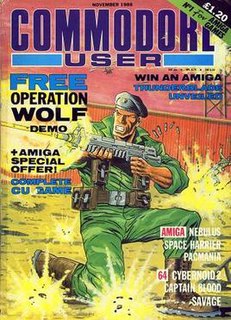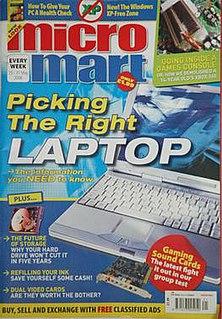
The Amiga is a family of personal computers introduced by Commodore in 1985. The original model is one of a number of computers with 16- or 32-bit processors, 256 KB or more of RAM, mouse-based GUIs, and significantly improved graphics and audio compared to previous 8-bit systems. This includes the Atari ST – released earlier the same year – as well as the Macintosh and Acorn Archimedes. Based on the Motorola 68000 microprocessor, the Amiga differs from its contemporaries through the inclusion of custom hardware to accelerate graphics and sound, including sprites and a blitter, and a pre-emptive multitasking operating system called AmigaOS.

Commodore User, known to the readers as the abbreviated CU, was one of the oldest British Commodore magazines. A publishing history spanning over 15 years, mixing content with technical and video game features. Incorporating Vic Computing in 1983 by publishers EMAP, the magazine's focus moved to the emerging Commodore 64, before introducing Amiga coverage in 1986, paving the way for Amiga's dominance and a title change to CU Amiga in 1990. Covering the 16-bit computer, the magazine continued for another eight years until the last issue was published in October 1998 when EMAP opted to close the magazine due to falling sales and a change in focus for EMAP. The magazine also reviewed arcade games.

Amstrad Action was a monthly magazine, published in the United Kingdom, which catered to owners of home computers from the Amstrad CPC range and later the GX4000 console.
Andrew Nicholas Oliver and Philip Edward Oliver, together known as the Oliver Twins, are British twin brothers and video game designers.

Amiga Power (AP) was a monthly magazine about Amiga video games. It was published in the United Kingdom by Future plc, and ran for 65 issues, from May 1991 to September 1996. It was in many ways a spiritual successor to Your Sinclair, which shared many of the same staff.

Your Sinclair, or YS as it was commonly abbreviated, was a commercially published and printed British computer magazine for the Sinclair range of computers, mainly the ZX Spectrum. It was in circulation between 1984 and 1993.

Dungeon Master is a role-playing video game featuring a pseudo-3D first-person perspective. It was developed and published by FTL Games for the Atari ST in 1987, almost identical Amiga and PC (DOS) ports following in 1988 and 1992.

Zzap!64 was a computer games magazine covering games on the Commodore International series of computers, especially the Commodore 64 (C64). It was published in the UK by Newsfield Publications Ltd and later by Europress Impact.

The One was a video game magazine in the United Kingdom which covered 16-bit home gaming during the late 1980s and early 1990s. It was first published by EMAP in October 1988 and initially covered computer games aimed at the Atari ST, Commodore Amiga, and IBM PC markets.

Epic is a space combat simulation game developed by Digital Image Design and published by Ocean Software for the Commdore Amiga and Atari ST in early 1992. A port to MS-DOS also appeared in the same year, followed by a version for the NEC PC-9801 in 1993. A sequel, titled Inferno, was released in 1994 for PCs only.

Micro Mart was a weekly computer magazine published in the United Kingdom by Dennis Publishing Ltd.. As of 2015, it had a circulation of 5,422. In a letter to subscribers in December 2016 it was announced that the magazine would cease publication with issue No 1445 : "After 30 amazing years of telling it like it is, Micro Mart magazine is logging off."

Antic was a magazine devoted to the Atari 8-bit family of home computers and later the Atari ST. It was named after the ANTIC chip which provides 2D graphics in the computers. The magazine was published from April 1982 until June/July 1990. Antic printed type-in programs, reviews, and tutorials, among other articles. Each issue contained one type-in game as "Game of the Month."

Amiga Format was a British computer magazine for Amiga computers, published by Future plc. The magazine lasted 136 issues from 1989 to 2000. The magazine was formed when, in the wake of selling ACE to EMAP, Future split the dual-format title ST/Amiga Format into two separate publications. At the height of its success the magazines sold over 170,000 copies per month, topping 200,000 with its most successful ever issue.
Europress was a British magazine and software publisher based in Adlington, near Macclesfield, Cheshire. Their magazine publishing business was previously known as Database Publications.

.info was a computer magazine covering Commodore 8-bit computers and later the Amiga. It was published from 1983 to 1992.

Amiga User International was a monthly computer magazine published in its later years by AUI Limited, it was the first dedicated Amiga magazine in Europe and in comparison to other Amiga magazines, AUI had a more serious perspective. One of the main features of AUI was the "AUI SuperDisks", which implemented multiple file systems and advanced compression techniques to hold far more data than a standard magazine cover disk.

Amiga Computing was a monthly computer magazine of a serious nature, published by Europress and IDG in both the UK and USA. A total of 117 issues came out. The games section was called Gamer, although later Amiga Action was incorporated into the magazine and became the games section.

Mega, subtitled "100% pure Sega Mega Drive...", was a monthly magazine, published in the United Kingdom, aimed at users of the Sega Mega Drive and its additions, the Mega-CD and 32X. During its time as one of the main Mega Drive publications, Mega covered the golden age of the Sega Mega Drive from 1992 to 1995. The magazine went through many changes including a re-design in content and layout before being sold to a rival publisher.
Warp3D was a project, founded by Haage & Partner in 1998, that aimed to provide a standard API which would enable programmers to access, and therefore use, 3D hardware on the Amiga.

Amiga Action was a monthly magazine about Amiga video games. It was published in the United Kingdom by Europress and ran for 89 full issues, from October 1989 to December 1996. After its closure, it was merged into sister publication Amiga Computing, replacing its games section. This ran for 10 issues until September 1997 when that magazine also folded.

















